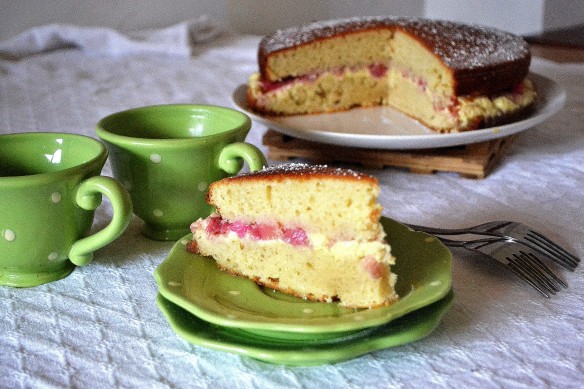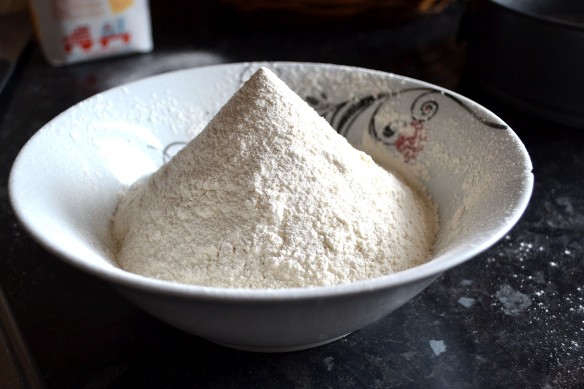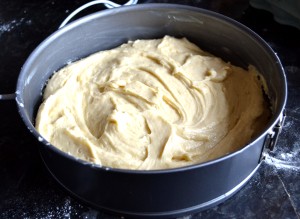 Many apologies for the long hiatus between blog posts. I have been travelling, eating, playing, and of course cooking. I’ve got fun posts coming up, including my new favorite restaurant in Paris and my foodie adventures in Istanbul. But for now I bring you this lovely cake.
Many apologies for the long hiatus between blog posts. I have been travelling, eating, playing, and of course cooking. I’ve got fun posts coming up, including my new favorite restaurant in Paris and my foodie adventures in Istanbul. But for now I bring you this lovely cake.
I was unfamiliar with that wonderful British classic, the Victoria sponge, until I moved to London. As with many traditional English sweets, this cake is a keeper. In its simplest form, Victoria sponge is just two vanilla sponge cakes, sandwiched around jam and clotted cream, or whipped cream and fresh berries, and dusted with powdered sugar. But of course this formula can be tweaked in numerous delicious ways.
I didn’t initially set out to make a Victoria sponge. I was cooking for a friend. “Shall I bake a cake?” I asked. “Yes!” he said.
“What kind of cake do you like?” I asked. “Gooey cake!” he said.
Earlier in the week I’d made a coffee cake with rhubarb on top. “How about a rhubarb cake,” I said, “with custard on the side?” “No no no!” he said. “Custard IN the cake.” After some thought, this is what I came up with.
Although there are a few components, this is an easy and – yes – gooey cake. Figure that including cooling time, this cake will require about four or five hours to prepare, but relatively little of this is active time. The custard is made with vanilla beans, which makes it especially nice against the buttery sponge and tangy rhubarb. I used self-rising flour for the sponge and added the eggs whole, rather than separating them, so the sponge is soft and dense. I also cheated (just a bit) and added a little blood orange juice to the rhubarb to keep it pink. Rhubarb is one of my favorite early spring treats, but you should feel free to make any variations you like. Strawberries that have been macerated in a little sugar would be a delicious alteration, as would a berry compote. Have fun, experiment, and happy Spring! 
You will need:
A spring-form cake pan, or two cake pans
A hand-held electric mixer, or a stand mixer
A rubber spatula
A whisk
A heavy-bottomed saucepan
A wire mesh strainer
Ingredients:
For the cake:
260 g (1 and ¾ cups) self-rising flour, sifted
200 g (seven ounces) unsalted butter, softened to room temperature and cut into chunks, plus additional butter for the cake pan
225 g (1 and ¼ cups) caster sugar
4 medium eggs
½ teaspoon salt
1 teaspoon vanilla bean paste or 2 teaspoons pure vanilla extract
60 g (about 1/3 cup) crème fraiche or sour cream
About a tablespoon of icing (powdered) sugar
For the custard
240 ml (1 cup) cream
240 ml (1 cup) milk, plus a little extra
2 egg yolks
1 whole egg
50 g (1/4 cup) sugar
½ vanilla pod
2 to 2 and ½ teaspoons corn starch
For the rhubarb
300 g (10.5 ounces) rhubarb, cut into ½ inch dice
100 – 150 grams (1/2 – 3/4 cup) sugar
Juice ½ blood orange (optional) 
Method:
For the cake
Preheat your oven to 350 degrees (180 degrees Celsius). Butter your cake pan well and set it aside.
In one bowl combine the flour and salt. In another bowl, beat together the soft butter, sugar, and vanilla paste until the mixture is light and fluffy. Add the eggs one by one, beating well after each addition. Fold in the flour mixture with a rubber spatula, then add the crème fraiche. The batter should be soft and loose but not liquid. If necessary, you can add a little more crème fraiche. Spread into your prepared cake pan(s). 
If you are using two cake pans, bake for 20 minutes in the center of the oven, or until the cake is golden brown and the center is firm and springy to the touch. My cake, baked in one cake pan, took exactly 40 minutes.
Take the cake from the oven, run a knife carefully around the sides, and loosen and remove the sides of the springform pan. Cool completely on a rack.
While the cake is cooling, prepare your custard and rhubarb.
For the custard
Split the vanilla pod, scrape out the seeds, and steep together with the milk and cream over very low heat for about ten minutes, being careful not to boil. Stir in the sugar until it is completely dissolved.
In a small bowl, mix together the corn starch (start with two teaspoons; if you need more, you can always add it later) with one or two tablespoons of milk until it is smooth. Set aside. In another bowl, beat the egg yolks and whole egg. Gradually ladle in about 1/3 of the hot milk/cream mixture to the eggs while whisking to temper them. Then add this to your saucepan, along with the corn starch mixture. Whisking constantly, cook until the custard has thickened to the point where the whisk leaves marks in the surface, i.e., about to the thickness of tapioca pudding. Immediately pour the custard through the wire mesh strainer into a bowl to remove any lumps. Cover with plastic wrap (the plastic should touch the surface, to prevent a skin from forming) and chill completely, about three hours.
For the rhubarb
Combine the rhubarb, sugar, and blood orange juice (if using) in a saucepan and heat over medium-low heat until the sugar has melted completely and is bubbling, about seven to ten minutes. Your rhubarb will still be firm at this point. Turn off the heat and let the rhubarb stand in the hot sugar mixture for about 15 minutes. Taste and add additional sugar if necessary, then transfer to a bowl or container and chill.
To assemble:
If you used one cake pan, the bottom of the cake will be your top. (If you used two cake pans, just make sure that the bottom of one of the cakes is on top.)
Using a sharp knife, slice the cake carefully in half and transfer the top of the cake to a dish, pressing down the sides slightly if necessary to keep the cake from wobbling.
Spread this piece with the custard, leaving about an inch and a half around the sides so the custard does not splooge out (my cake is a cautionary example of sploogy custard). Spoon the rhubarb over the top, using just the poached pieces, and leaving the liquid. Loosen the remaining cake half from the springform base with a knife, turn it out onto your hands, and place on top, with the smooth bottom side up.
Keep chilled until ready to serve. Just before serving, dust powdered sugar over the top.  Makes about 12 servings.
Makes about 12 servings.

The cake looks wicked….so cool to have a pink gooey in the middle cake….perfect!
Thanks Asma! xx
Gorgeous… I love rhubarb, and I always think of the ‘rhubarb pie’ song!
Hm… I don’t think I know the rhubarb pie song. Although now I want to eat rhubarb pie. 😉
sounds ace! I also only got introduced to the victoria sponge after I came to the uk. it is essentially a giant jam sandwich made of cake instead of bread, and with an extra spread of cream. trust the english to do sth like that. love the rhubarb and custard version, slight bit of tang to freshen things up from the rhubarb! good one! lookign forward to your istanbul posts! (why’s everyone gone on holiday there?!)
I noticed that too! Very funny/bizarre. I agree about the Victoria sponge. I may need to make the classic next, with clotted cream and jam. 😀
Looks lovely Susan! I love rhubarb a lot. I remember eating a rhubarb custard tart at the train staion in Frankfurt. It was the first time that I had ever eaten rhubarb with custard and I, of course, loved it. Your cake looks like a great way to celebrate the beginning of Spring.
Thank you Gene. Rhubarb and custard is such a popular combination here that there is a candy called rhubarb and custard. I love English sweets.
This looks fabulous, Susan! Bravo! As soon as I get over this cold, I am going to go out and see what’s at the Farmers Market. Hopefully rhubarb!
Can’t wait to hear about Istanbul too, one of my favorite cities. I was eagerly following your escapades on twitter, wondering if we ate at the same places . . .
No worries about irregular postings. In between job apps, teaching, and being sick, I have been that way too lately.
Thank you Daisy. I’m sorry to hear that you have been sick. Are you feeling better?
Marginally. Slept for twelve hours last night. Spring colds are the worse!
I have most wonderful memories of eating a version of this with you in the V & A tearoom. Fantastic! I am looking forward to making this. 🙂
In that wonderful, wonderful tearoom. 🙂 Tell me what you think if you do try it.
Love the cake. Can’t wait to read about Paris and Istanbul. And, how did you make that flour look like the Great Pyramid of Giza?
😀 I sifted the flour through a wire mesh strainer. It reminded me of the spice displays in Morocco, but I prefer the Great Pyramid (think big).
Your cake looks so delicious, I love the idea of the rhubarb and custard filling!
Thank you, Rosie, and thank you for dropping by. Come again soon!
Susan
There is nothing like custard in the cake to get you going. Looking forward to your adventures
Thank you Tanya. I wish I were still on my adventures!
I’ve never heard of the Victoria Sponge, so thanks for the introduction. This looks like another winner, Susan!
daisy
🙂
Thanks, Daisy!